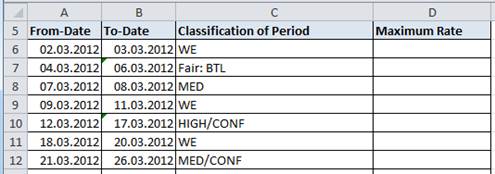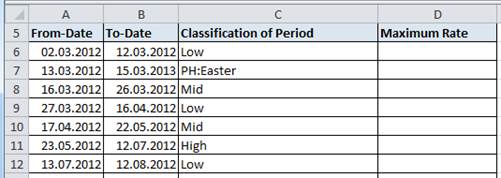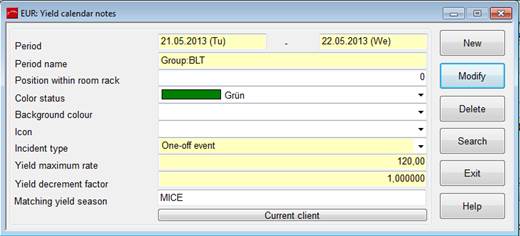
An important step in setting up SIHOT.RMS is the definition of calendar notes in the master files menu. The periods defined here are used to classify booking behaviour patterns. Each day must be assigned to a yield classification period.
The yield classification periods are used to:
1. calculate a reference booking behaviour pattern for the past.
2. establish a forecast for the future based on this reference booking behaviour pattern.
For a better overview, it is recommended to prepare a listing of the classification periods before entering them in SIHOT. In this listing, specify periods and classify them by booking behaviours. Special events, trade fairs, exhibitions and any one-off or recurring events that influence the occupancy should also be mentioned. In addition, the calendar should include a maximum rate, which is based on room only net for the most favourable room type expected to materialise.
è EXAMPLE: In a city hotel, typical periods include weekends (WE), medium demand periods (MED), periods of high demand with conferences (HIGH/CONF) and trade fairs (Fair:…)

Figure 11: Sample yield calendar city hotel
è EXAMPLE: In a resort hotel, typical periods include low seasons (Low), mid-season (Mid), high season (High) and public holiday periods (PH:…)

Figure 12: Sample yield calendar resort hotel
In the yield calendar notes-dialog recurring periods or seasons should always be spelled the same way, e.g. High for high season periods. Enter the word “closed” in the period name-field to exempt calculations for this period, for example if the hotel is closed at the end of the season.
The field incident type differentiates events that only happen once or events or periods that keep recurring, e.g. holiday periods, which always show a similar pattern in booking behaviour.
The yield maximum rate is the net accommodation rate that is used to calculate the hurdle. I.e. it is the rate that should be obtained if the booking pattern in the past and the current booking pattern are similar. If current demand is higher than it was in the reference period, the hurdle will increase accordingly.
The yield decrement factor is used to improve the calculations as long as there is not sufficient reference data available. The more yield-data is collected during time, the lower this factor will be.
Assign a matching yield season to one-off events, so that SIHOT can base the calculation of the booking behaviour during this period on similar events.

Figure 13: Yield calendar notes
i TIP: The name of the season is shown in the X-axis of the forecast graphs.